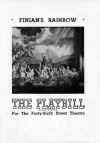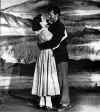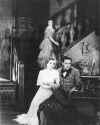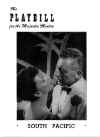History of The Musical Stage
1940s Part IV: New Talents, New Hits
by John Kenrick
(Copyright 1996; revised 2014)
(The images below are thumbnails – click on them to see larger versions.)
New Talents
 The
original cast Playbill for Finian's Rainbow (1947).
The
original cast Playbill for Finian's Rainbow (1947).
In the late 1940s, a number of new creative talents caught on to what Rodgers and Hammerstein had really accomplished. This resulted in several outstanding musicals that would remain popular for decades to come.
Finian's Rainbow (1947 - 725 performances) was the first musical to tackle racism with laughter, proving that the integrated musical could work as social satire. It told the story of an Irishman who steals the leprechauns' legendary crock of gold and buries it near Fort Knox, thinking it will grow in such "rich" soil. While the Irishman's daughter falls in love with an American, an avenging leprechaun is distracted by human love -- and an innocent wish turns a bigoted Southern congressman into a Negro. David Wayne played Og the leprechaun, becoming the first performer in a musical to receive the Theatre Wing's new Antoinette Perry Award, later known as "The Tony." Composer Burton Lane and lyricist E.Y. "Yip" Harburg's score included "Look to the Rainbow," "That Old Devil Moon," and "How Are Things in Glocca Morra."
 Priscilla Gilette and David Brooks sing
"Almost Like Being in Love" on the program cover for the first national tour of
Brigadoon.
Priscilla Gilette and David Brooks sing
"Almost Like Being in Love" on the program cover for the first national tour of
Brigadoon.
In a more romantic vein, lyricist/librettist Alan Jay Lerner and composer Frederick Loewe found success with the story of two men who stumble into a town that magically reappears in the Scottish highlands for only one day every century. Brigadoon (1947 - 581 performances) was graced with a ravishing score that included "Almost Like Being In Love" and "There But For You Go I." Agnes DeMille contributed several ravishing ballets, helping to make Brigadoon became one of the most frequently revived musicals in the international repertoire.
Tin Pan Alley songwriter Frank Loesser was best known for his wartime hit "Praise the Lord and Pass the Ammunition." His first Broadway score was for Where s Charley (1948 - 792 performances)), based on the old British comedy Charley s Aunt. The sweet ballad "My Darling" made it onto the pop charts, but it was Ray Bolger's rendition of "Once In Love With Amy" that caused a sensation -- thanks to a happy accident. One night early in the run, Bolger heard the audience chuckle partway through the song. It seems a a child had begun to sing along with him. The veteran showman encouraged the youngster, then got the whole audience to join in. Enchanted, the audience demanded encores, literally stopping the show. The sing-along became a permanent part of the show, catapulting Where's Charley to hit status, and giving Bolger his most memorable stage moment.
By the end of the 1940s, integrated musical plays, both serious and comic, dominated the Broadway landscape. The greatest composers in American popular music were all working in this new form.
- Composer Kurt Weill and
playwright Maxwell Anderson's Lost in the Stars
(1949 - 273 performances)) examined the nightmare of South African apartheid decades before
it became a widely discussed issue.
- Irving Berlin's
Miss Liberty (1949 - 308 performances)) had a book by
Pulitzer-winning playwright Robert E. Sherwood,
telling the story of a newspaper reporter trying to identify the woman who posed for
the Statue of Liberty. The score included "Give Me Your Tired" and
"Let's Take an Old Fashioned Walk."
- Composer Jule Styne and lyricist Leo Robin turned the popular Anita Loos 1920s novel Gentlemen Prefer Blondes (1949- 740 performances)) into a smash hit musical comedy -- integrated, but with enough lighthearted fun to rate as a musical comedy. As Lorelei Lee, the gem-hungry flapper with a heart of pure gold, Carol Channing found stardom, stopping the show with her wide-eyed renditions of "Little Girl from Little Rock" and "Diamonds Are A Girl's Best Friend."
The 1940s in London
Few London productions of 1940s drew much attention outside of Britain, but the West End had its share of homegrown musicals. Broadway producers felt that most of these shows were "too British" to appeal to American theatergoers. Even the perennial transatlantic favorite Noel Coward was unable to turn out a hit musical in this decade. After World War II, his Pacific 1860 (London 1946 -129 performances) faired poorly despite a lavish production and the presence of Mary Martin.
London's most popular star during the mid-twentieth century was Ivor Novello, an actor-songwriter who composed and starred in a series of hit operettas, despite the fact that he couldn't sing a note. With striking good looks, a winning stage presence, and a gift for writing lush melodies, Novello played leading roles and left the singing to everyone around him. To make this less awkward, he often played characters that accompanied others on piano.
 Ivor Novello
makes one of his non-singing appearances in
The Dancing Years with Roma Beaumont and Mary Ellis (on the
stairs).
Ivor Novello
makes one of his non-singing appearances in
The Dancing Years with Roma Beaumont and Mary Ellis (on the
stairs).
Novello got away with this arrangement in show after show, cheered on by a hoards of female fans who had no idea their idol was a homosexual. With a mixture of affection and envy, longtime friend (and competitor) Noel Coward said that "the two loveliest things in the British theatre are Ivor's profile and my mind." Novello's almost continuous string of musical hits included –
- Glamorous Night (1935 - 243 performances)
- Careless Rapture (1936 - 297 performances) – wags dubbed this one "Careless Rupture"
- Crest of the Wave (1937 - 203 performances)
- The Dancing Years (1939 - 967 performances) – this one was nicknamed "The Dancing Queers"
- Perchance To Dream (1945 - 1,022 performances)
- King's Rhapsody (1949 - 839 performances)
- Gay's The Word (1951 - 504 performances)
None of Novello's shows (which often contained enough gooey sentiment to choke a drainpipe) were ever produced on Broadway, so even his most popular songs ("Shine Through My Dreams," "Waltz of My Heart") were rarely heard outside of Britain. And that's a pity, because his gift for polished, romantic melody placed him somewhere between Coward and Franz Lehar. Novello's dominance of the London stage continued until his sudden death at age 58, when he was starring in King's Rhapsody. Thousands lined the streets on the day of his funeral, which was broadcast live over British radio to a mourning nation.
The longest running West End book musical from this period was Me and My Girl (1937 London - 1,646 performances), the story of a poor London cockney who inherits a nobleman's title and fortune. The Noel Gay score included the catchy "Lambeth Walk," and Brits packed the theatre through most of World War II. British comedian Lupino Lane triumphed in the lead and starred in several revivals. But American producers felt Me and My Girl was "too British" for Broadway. In 1985, London welcomed a heavily revised version starring Robert Lindsay. After a rip-roaring triumph in London (where it ran for years), Me and My Girl finally traveled to New York in 1986, where it racked up a healthy 1,420 performances. It seems even thick-headed Yanks can eventually catch on to a bit of alright.
South Pacific
 Mary Martin and Metropolitan Opera star Ezio Pinza on the original cast
Playbill for South Pacific.
Mary Martin and Metropolitan Opera star Ezio Pinza on the original cast
Playbill for South Pacific.
As the 1940s ended, New York was the undisputed center of the theatrical world, and Broadway's last musical hit of the decade was one of the biggest ever. Working with co-librettist and director Josh Logan, Rodgers and Hammerstein wrote a musical based on two stories from James Michener's Tales of the South Pacific. Set on a tropical island occupied by American forces during World War II, it told of military nurse Nellie Forbush falling in love with French planter Emile de Becque, and of upper-crust Lieutenant Cable giving his heart to a Polynesian girl. Romance forces these two "decent" Americans to confront the bigotry they were taught at home. Set amid the life and death tensions of wartime, it was a world away from the whacky musical comedy librettos that had reigned on Broadway at the start of the decade.
With powerhouse stars Ezio Pinza and Mary Martin, a well crafted script, and a score that included "Some Enchanted Evening," "Younger Than Springtime," "Bali Hai," and "I'm In Love With A Wonderful Guy," South Pacific (1949 - 1,925 performances) proved to be a critical and commercial sensation, creating an unprecedented demand for tickets. Some critics (to be specific, the idiotic ones) have suggested that aspects of the book seem dated today, but the show's score and genuine sentiment still work.
South Pacific was unusual in many ways. There was almost no dance, two equally important love stories, and the dramatic tension was not provided by any single antagonist (a.k.a. - a "bad guy") or "silly misunderstanding." Both love stories were u against "carefully taught" racial prejudices. These reflex hatreds drive key characters to push away from the people they love. In the case of a young Lieutenant and his native girl, the results are tragic, but Nellie and Emile are finally reunited.
South Pacific confirmed Rodgers and Hammerstein's command of the genre. Along with worshipful reviews, it won the Tony for Best Musical and became the second musical to receive the Pulitzer Prize for Drama. Tony awards also went to the authors, as well as Pinza, Martin and other company members. Rodgers & Hammerstein's knack for creating innovative and entertaining hits came to be called "The RH Factor," and it would keep them on top through the next decade.
The Shuberts: A Matter of Trust
South Pacific triggered a surprising, radical change in the "business we call show." Tickets were in such demand that theatre owners Lee and J.J. Shubert got greedy. They arranged for ticket brokers to charge theatergoers up to ten times the legal box office value of eight dollars, with the Shuberts pocketing most of the price increase. They even made top politicians pay these inflated prices, which proved to be a foolish mistake. Congress launched a long overdue investigation of Broadway business practices, accusing the Shuberts of functioning as an illegal trust.
The Shuberts used high powered lawyers to draw out the struggle for several years, but after a series of court battles, the Federal government won its case. The Shuberts were forced to give up their lucrative control of theatre bookings and ticket sales, and to sell off a large number of their theatres all across the USA. Although the brothers remained powerful, their stranglehold on the commercial theatre was broken.
The 1940s had seen vast changes in the musical theatre, both as an art form and as a business. World War II had re-energized the American economy, and many great musicals appeared in the 1940s, particularly after Oklahoma (1943) redefined the genre. But as theatre rents, union minimums and advertising costs kept climbing, it became harder for shows to turn a profit. So even as the American musical enjoyed what many have called its "golden age," the number of Broadway productions continued (with occasional exceptions) a gradual but inexorable decline.
This decline was easy to overlook in the decade that followed. After all, in the 1950s, the Broadway musical was one of the most popular genres in all of show business.
